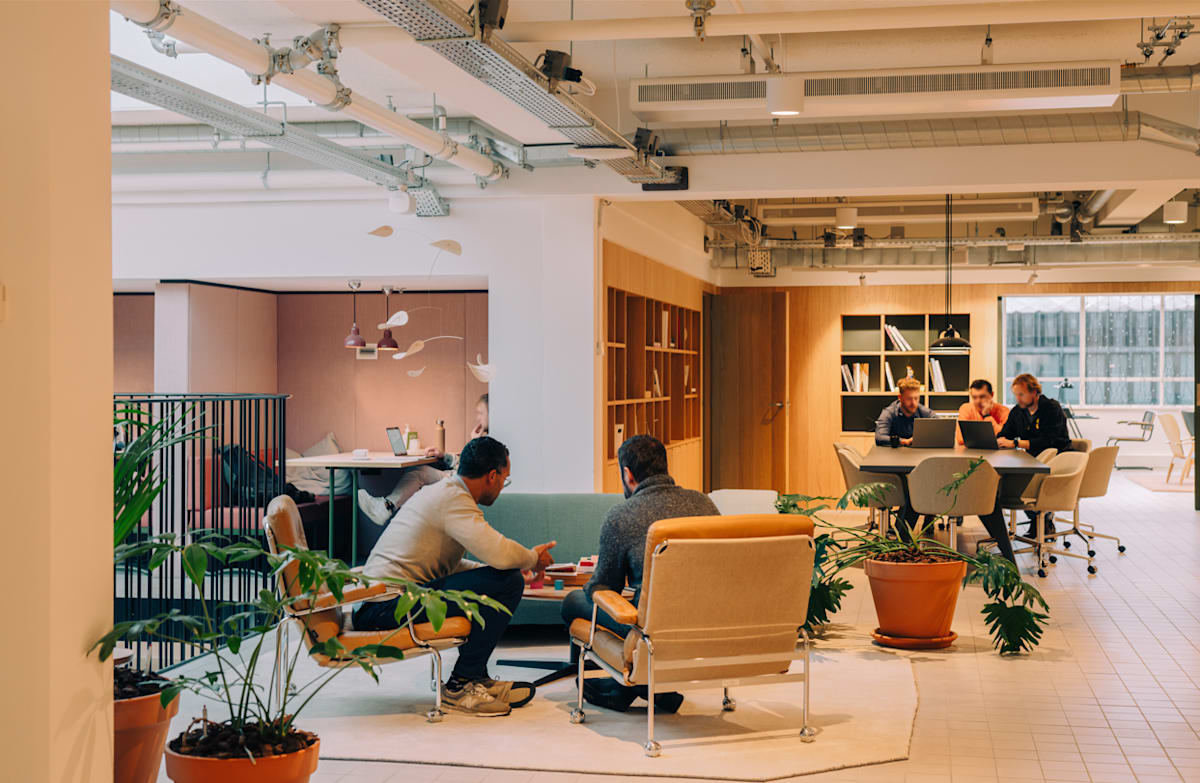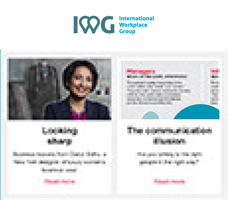- Study shows hybrid work can boost productivity by 11%, building on existing academic research
- Hybrid working, facilitated by flexible spaces, could bring up to $566 billion in GVA annually to the US economy by 2045 – the equivalent GVA of Austin, Texas
- Employees reporting their productivity levels as ‘excellent’ in flexible workspaces and offices closer to home is 67% higher than those solely working from home
- Employee quit rates could be reduced by up to 20% in the hybrid model, generating annual savings of $45 billion for companies by 2045
- Employees are making huge savings too – US workers can save up to $30,332 per year if they switch from a daily commute to a city centre to working locally four days a week
- International Workplace Group added 899 new locations globally in 2024, posting record revenue, EBITDA and cash generation as businesses looked for first class, efficient, flexible working space in places that suit their employee needs
New global research from International Workplace Group (IWG) and global engineering consultancy Arup shows that businesses empowering employees to use local workspaces and offices as part of their hybrid working approach could boost productivity by 11% over the next five years.
This latest figure combines research from the National Bureau of Economic Research, which looks at how much time saved from commuting is reallocated to work, and from the Economist Impact’s study on time lost to distractions when working from a company HQ in the US. These findings build on previous academic research from the likes of Professor Nicholas Bloom of Stanford University which highlighted that hybrid work boosted productivity by 3-4% in a randomised pilot conducted for Trip.com.**
Hybrid working could add up to $566B to the US economy by 2045 – equivalent to the entire GVA of Austin, Texas.
The “IWG Hybrid Working Productivity Report” analysed the potential impact on business performance and economic growth if more white-collar workers were to work in the hybrid model in offices and workspaces in the heart of local communities.
The study shows that hybrid working could generate $219 billion in GVA annually by 2030 to the US and $566 billion by 2045 – the equivalent to the GVA of Austin, Texas – through increased productivity, reduced turnover, replacement costs and portfolio costs. In the UK, productivity could increase by 12%, contributing £24 billion in GVA to the economy each year, with that impact increasing to £46 billion by 2045, equalling the contribution of the city of Leeds.
Hybrid work: driving productivity gains and saving economies billions per year.
This 11% productivity boost is driven by lower commutes, with employees benefiting from increased focus time and fewer distractions, ultimately spending up to 40% of time saved from travelling on additional work. In fact, the rate of employees reporting their productivity levels as ‘excellent’ in flexible workspaces is 67% higher than those working from home.
This more productive use of time has the potential to have a significant impact on businesses and the economy. If workers spend half their time in local flexible workspaces or offices – gaining improved focus and saving time on commutes – it could unlock 170 extra productive hours per worker, each year. That’s the equivalent to $42 billion in annual GVA within five years, rising to $109 billion by 2045. Just by using a flexible workspace “occasionally”, remote companies could reduce costs by $5bn a year by 2030.
Hybrid working is also proving to be essential to employee retention. Flexible arrangements can reduce voluntary turnover rates by up to 20%; in the US, this could translate to annual savings of $22 billion by 2030 and $45 billion by 2045. These predicted savings stem from lower recruitment and training costs, with employees three times more likely to stay in roles where they can choose flexible working options.
Workers are reaping the rewards of being able to work closer to home, too, and access workspaces locally. Removing the need to commute brings significant cost-savings to employees – US workers can save up to $30,332 per year if they switch from a daily commute to a city centre to working locally four days a week.
Companies shifting to local hubs or coworking memberships can cut real estate costs by 55%, saving US businesses up to $122B by 2045.
By adopting hybrid working and flexible office spaces businesses can also significantly cut their real estate costs and reduce overheads, while also providing access to higher-quality workspaces at a fraction of the cost of traditional long-term leases.
According to the study, companies transferring all their portfolios in neighbourhood hubs or providing coworking memberships to their employees as opposed to space in central offices are expected to reduce real estate costs by 55% in the US. On a broader scale, US companies could collectively save up to $58 billion annually by 2030 and $122 billion annually by 2045 by shifting to less centralised locations or leveraging flexible workspace memberships.
Mark Dixon, CEO and Founder of International Workplace Group, commented: “Our latest study with Arup builds on the growing body of academic research showing the compelling productivity gains of hybrid working. When businesses give employees the freedom to work closer to home in well-equipped spaces without the need for longer daily commutes the results are clear: better focus, fewer distractions and improved work-life balance, all of which translate into meaningful productivity gains. These benefits, when scaled, have the potential to deliver billions in value to economies around the world.
“Put simply, it’s a win-win for both companies and their teams. Employees are more engaged with an improved work-life balance, while businesses benefit from higher productivity, lower real estate and recruitment costs and ultimately, a happier workforce.”
He continues: “In 2024, International Workplace Group signed a record 899 new centres, many in suburbs or smaller towns, driven by the increasing demand for hybrid working in locations closer to where employees live. The office isn’t dead, it’s just moved closer to where people live – and businesses adopting this way of working will reap significant rewards.”
Katie Randall, Leader of City Economics & Strategy, Arup added: “As organisations rethink the role of the workplace, hybrid models can be a catalyst for both personal and economic growth. Empowering employees to choose flexible, local workspaces not only sharpens concentration and reduces commuting stress but also fuels a culture of satisfaction and loyalty.
“The ripple effects are profound: companies see stronger performance, communities thrive with new business hubs, and the global economy stands to gain significantly. With productivity growth a key priority for national governments, our research shows that hybrid working forms a helpful part of the solution.”
ENDS
Notes to editors
*IWG Hybrid Working Productivity Report
**What We Know Now About the Business Impact of Hybrid Work, Professor Nicholas Bloom
About this report
IWG and Arup have partnered to investigate how the rise of flexible working brings organisational value to different types of businesses. In a novel approach, this research addresses how firms of various needs, structures and spatial arrangements get impacted differently by the rise of flexible working.
The study focuses on three distinct firm typologies making use of flexible spaces to improve their working arrangements:
- ‘Distributed locals’ organisations – Firms whose employees work from multiple locations in assigned and privatised spaces in local flexible spaces mainly located in suburban and secondary towns. There is no central physical office or HQ.
- ‘Hub-and-spoke’ organisations – Medium to large firms combining a central office with hybrid working arrangements from home or from firm-dedicated flexible spaces.
- ‘Remote-first’ organisations – Firms whose operating model is mainly remote and that have no physical office or headquarters. Teams gather regularly (once a month / quarterly) in flexible spaces for in-person collaboration.
Embracing hybrid working can make businesses more productive, cost-efficient and attractive.
The study considers the potential economic impact of an increased number of firms using flexible and more efficient ways of working, and the opportunities for growth going forward. In the scenario-based analysis created for this report, we discuss:
- The new geography of work and how companies are adapting their hybrid working arrangements and transferring portfolios to flexible spaces.
- The broader benefits of hybrid working such as reduced commutes and the money saved, increased focus time, real estate savings, satisfaction and health and wellbeing benefits.
- The potential impact of localised hybrid working in decentralised offices increasing employee satisfaction and retention.
- The implications of adopting a hub-and-spoke model and how it can improve management practices, efficiency and reduce real estate costs.
- The impact on remote companies making use of flexible spaces to build employee engagement, increase collaboration and improve retention.
This study was carried out between October and December 2024.
About International Workplace Group plc
International Workplace Group (IWG) is the world’s leading platform for work enabling companies of all sizes to work more productively and profitably. We create personal, financial, and strategic value for the most exciting companies and well-known organisations on the planet, as well as individuals and the next generation of industry leaders. All of them harness the power of IWG’s platform to increase their productivity, efficiency, agility and market proximity.
IWG's unrivalled network coverage includes more than 4,000 locations across 120 countries, and 83% of Fortune 500 companies are amongst our growing customer base.
Our brands including Regus, Spaces, HQ and Signature serve millions of people, providing professional, inspiring and collaborative workspaces, and all our digital services are available via the IWG app.
For more information
Visit iwgplc.com and for more information on partnering with International Workplace Group, see: iwgplc.com/develop-a-location.
To read the report in full, visit: IWG Hybrid Working Productivity Report.
About Arup
Dedicated to sustainable development, Arup is a collective of more than 18,000 designers, advisors and experts working across 140 countries. Founded to strive for humanity and excellence in everything that we do, we collaborate with our clients and partners, using imagination, technology and rigour to shape a better world.


